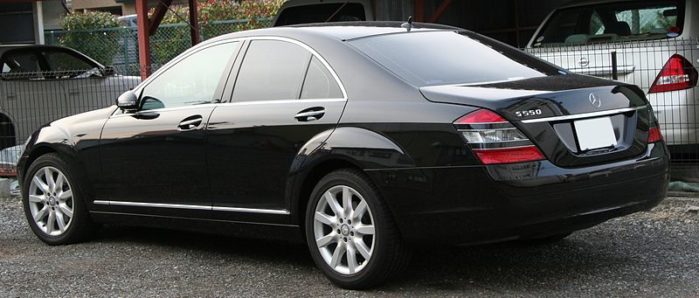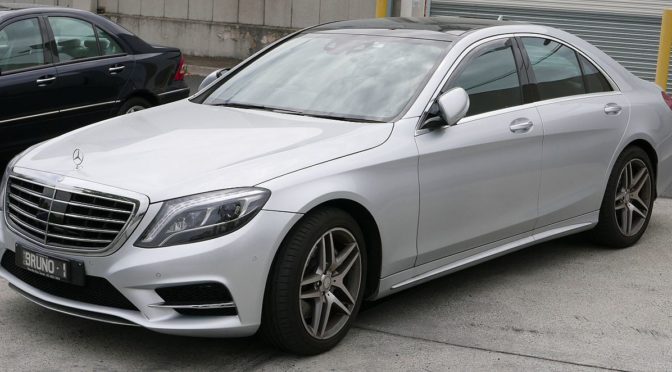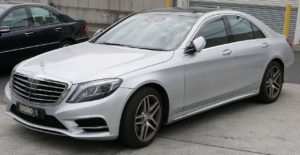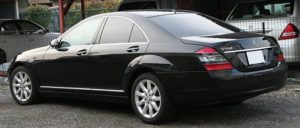If you’re buying a Mercedes-Benz S-Class, you’re looking for something beyond an ordinary driving experience. Fortunately, when you buy an S-Class, whether new or used, you’re also buying one of the safest cars on the road at the time of manufacture. A larger version of the E-Class and the flagship of Mercedes-Benz, the S-Class has few rivals; two German examples include the BMW 7-Series and the Audi A8. Volvo doesn’t have a direct equivalent; their closest is the Volvo S90.
Regardless of why you bought the S-Class, it makes a fine family car if you value a good amount of room for passengers and a good amount of safety on the road. Today we’ll take a look at how it does fitting 3 car seats across the back row. Before we do, though, here’s a quick primer on best practices in car seat safety.
First of all, everything starts with rear-facing when it comes to car seat safety. Whether you’re 8 hours old or 80 years young, you’re best off rear-facing. Practically speaking, if you can keep your little ones rear-facing until at least 5, the way the Swedes do, you’re on the right track. At that point, if you wish, you can switch to forward-facing. To be honest, you can keep rear-facing too, but if you forward-face, know that you can also switch directly from rear-facing into boostering if your children are ready. From then on, you’ll want to keep your kids in high-back boosters until they’re ready to use adult seat belts; this typically won’t happen until they’re at least 10 to 12. Beyond that, I suggest keeping kids in the back seat until at least 13, and delaying teen solo driving until 18 if possible. It’s not a race; keep kids in earlier stages if possible for as long as possible.
The guide below represents only a fraction of available combinations for the S-Class; if you find other combinations that work, feel free to let me know through the forums; I’ll add more seats as I get the chance to test them.
You can access the complete 3 across guide for every vehicle here and the complete list of recommended seats here. The Canadian car seat guide is here. 3 across car seat images are courtesy of Wikipedia or the NHTSA.
2014, 2015, 2016, 2017, 2018, 2019, 2020 Mercedes S-Class (W222, C217, A217)
Guaranteed 3 across installations:
Clek Fllo (x3).
Clek Foonf (x3).
Clek Oobr (x3).
Maxi-Cosi RodiFix (x3).
Peg Perego Flex 120 (x3).
Maxi-Cosi RodiFix (x3).
Diono Radian 3RXT (x3).
Diono Radian 3RX (x3).
Diono Radian R120 (x3).
Diono Radian RXT (x3).
Diono Radian R100 (x3).
Chicco KeyFit 30 (x3).
Graco Size4Me 65 (x3).
Graco Contender (x3).
Combi Coccoro (x3).
Clek Fllo, Diono Radian / RXT, Diono Radian / RXT.
Clek Fllo,Graco Size4Me 65, Graco Size4Me 65.
Clek Fllo, Graco Size4Me 65, Diono Radian / RXT.
Tips and Tricks:
The W222 Mercedes-Benz S-Class generation is 201 inches long in the short wheelbase and 206 inches long in the long wheelbase version; both are just under 75 inches wide. In other words, you’re going to be able to fit most car seats inside without much trouble as long as you’re willing to use seat belts instead of LATCH for the wider ones. Remember that there’s no safety difference between seat belts and LATCH, but seat belts are much more efficient in helping you squeeze out every available inch of space in your back seats. The center seat is the narrowest and is where you’ll want to install the narrowest seat.
2006, 2007, 2008, 2009, 2010, 2011, 2012, 2013 Mercedes S-Class (W221)
Guaranteed 3 across installations:
Clek Fllo (x3).
Clek Foonf (x3).
Clek Oobr (x3).
Maxi-Cosi RodiFix (x3).
Maxi-Cosi RodiFix (x3).
Diono Radian 3RXT (x3).
Diono Radian 3RX (x3).
Peg Perego Flex 120 (x3).
Diono Radian R120 (x3).
Diono Radian RXT (x3).
Diono Radian R100 (x3).
Chicco KeyFit 30 (x3).
Graco Size4Me 65 (x3).
Graco Contender (x3).
Combi Coccoro (x3).
Clek Fllo, Diono Radian / RXT, Diono Radian / RXT.
Clek Fllo,Graco Size4Me 65, Graco Size4Me 65.
Clek Fllo, Graco Size4Me 65, Diono Radian / RXT.
Tips and Tricks:
The 5th generation S-Class is 206.5 inches long and just under 74 inches wide; as with the 6th generation, you’ll have a lot of flexibility when it comes to car seat installations, even if you won’t have quite as much width to work with. However, since width is more important than length when it comes to car seat installations (at least in 3 across setups), you’ll want to pay close attention to using seat belts instead of LATCH when dealing with wider car seats. Seat belts are just as safe as LATCH but make much more efficient use of seating room, which allows you to fit wider seats together than you otherwise would with LATCH.
 If you find my information on best practices in car and car seat safety helpful, you can buy my books here or do your shopping through this Amazon link. Canadians can shop here for Canadian purchases. Have a question or want to discuss best practices? Send me an email at carcrashdetective [at] gmail [dot] com.
If you find my information on best practices in car and car seat safety helpful, you can buy my books here or do your shopping through this Amazon link. Canadians can shop here for Canadian purchases. Have a question or want to discuss best practices? Send me an email at carcrashdetective [at] gmail [dot] com.





